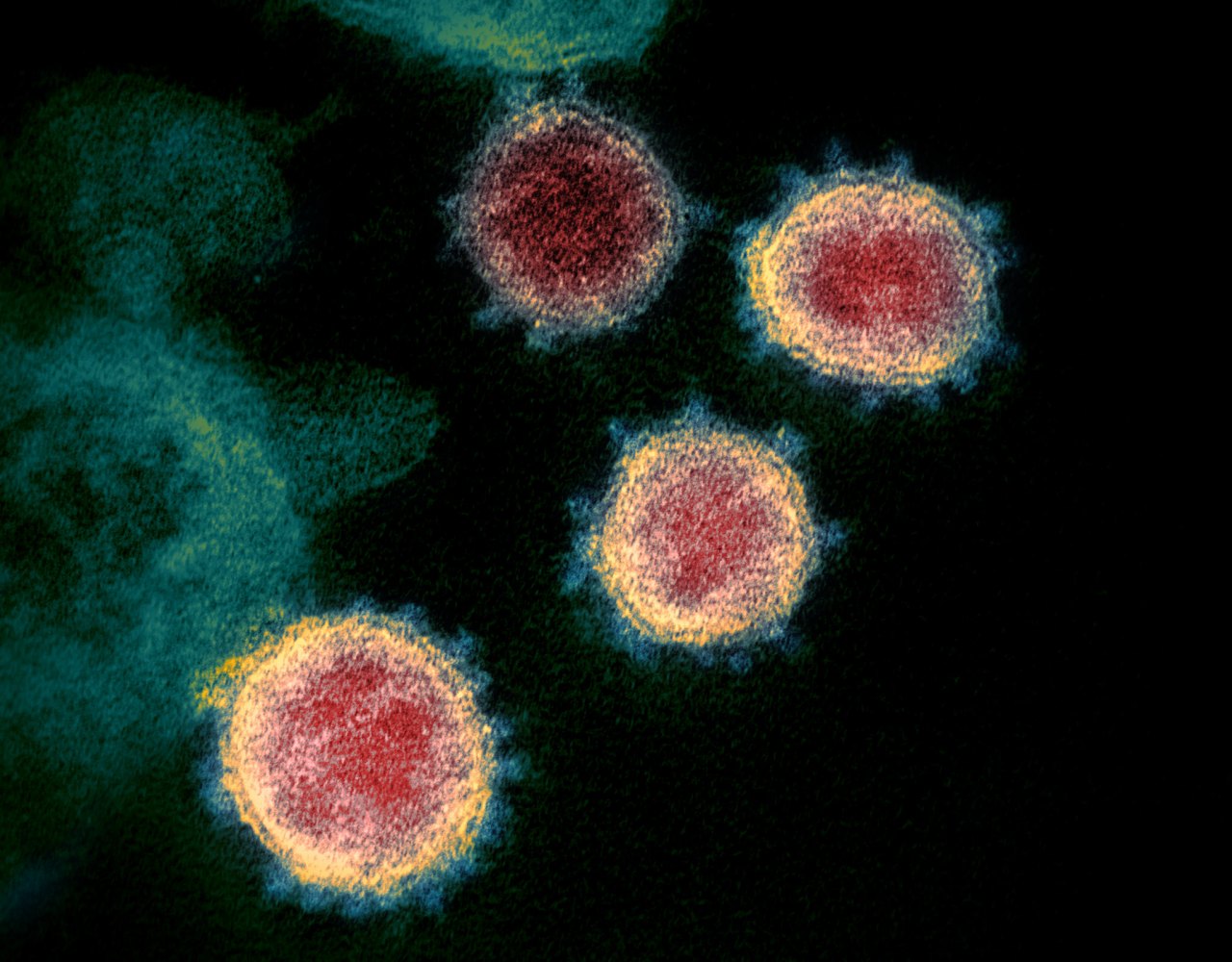
The Coronavirus — What’s Up With That? Tips, Analysis, And Facts To Keep You Informed
This article is continually updated tracker of resources, summaries and links about Coronavirus or COVID-19 from the US based publication. Email us with corrections, additional links, and your insights.
[*] Is coronavirus (COVID-19) killing people? There are two great coronavirus trackers available online that show how many people are dying and how many are recovering. The ArcGIS tracker has a great interface. Coronatracfonker.com has a slightly different visualization method.
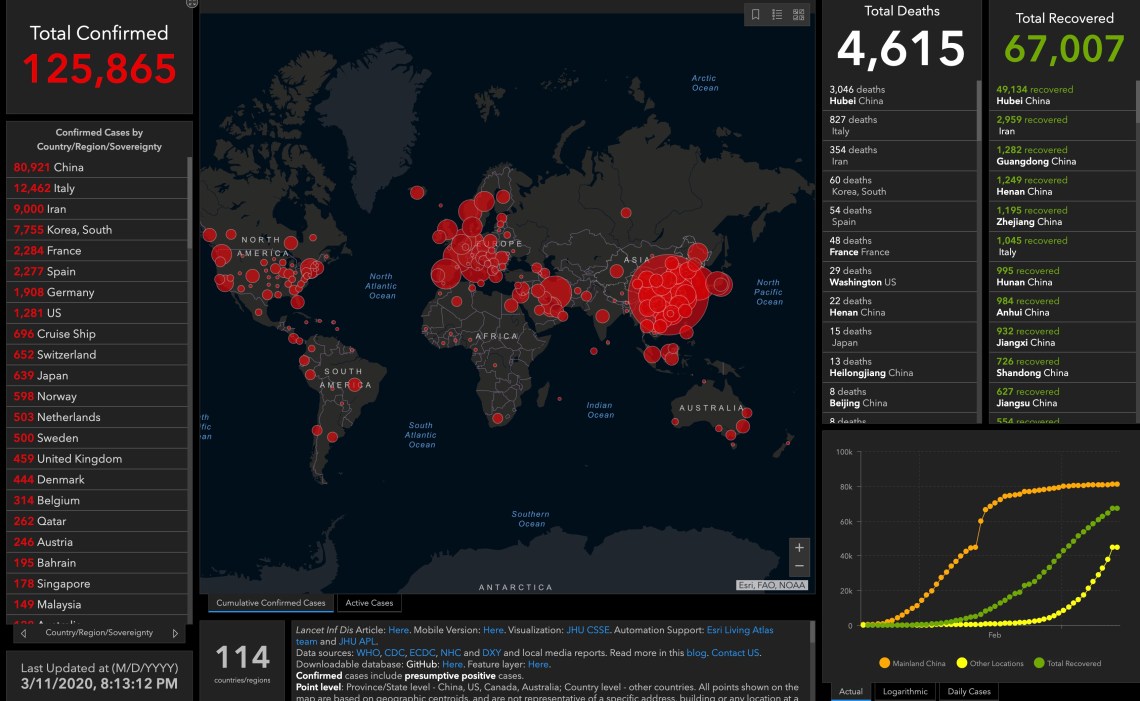
[*] How many people have COVID-19 in the United States? We don’t know that number because so few people are being tested for it. Here is a data-driven report on the testing process (or lack thereof) and here is a first-hand report from a women whose husband likely has COVID-19 but could not get tested.
We were then told he didn’t meet the CDC mandated criteria for COVID-19 testing: he wasn’t hospital-level sick, he hadn’t been in contact with anyone who was KNOWN to be infected, or he hadn’t been to a “high-risk” country. Since he was negative for everything else, but we couldn’t get him tested for COVID-19, our doctor told us to proceed as if he did test positive and told us to self-isolate and take all precautions.
[*] We also don’t know if the numbers from other countries are accurate yet, particularly the numbers from China. Yet globally experts at John Hopkins say it’s impossible to get an accurate tally about the global outbreak because each country approaches testing and statistics-gathering differently.
[*] Is it going to kill me? Old people and men seem to be most at risk, according to Stat News as of March 11. It seems young people with no underlying health conditions recover quickly and at home.
[*] What does it feel like to have coronavirus? The main symptoms seem to be a cough, a fever, shortness of breath, and an achy body. Here is how one person who had coronavirus and recovered explains it: “I just wanted to curl up into a ball and I had ear problems and sinus problems where it felt like there was a balloon being blown up in my face. And that was probably the worst symptom. It really bothered me. I also had a raking cough. It was terrible. And it was happening so much, I lost my voice. Sometimes, I couldn’t make any sound at all. Sometimes, I sounded like a frog.”
[*] The World Health Organization (WHO) declared the spread of the coronavirus to be a global pandemic on March 11, 2020. The last time they officially declared a pandemic was the “Swine Flu” (H1N1) in 2009, which killed an estimated 10,000 people.WHO has been around since 1948. Here is a full video of their announcement.
[*] Is coronavirus overblown? We don’t know because we don’t have enough information yet. However, in the face of pandemic uncertainty, the proper response is one of extreme caution, and we should assume the worst given what we do know.
[*] Why should we be extremely cautious if we don’t know 100%? Because while uncertainty is still the name of the game, we do know there is a real chance that a great deal of the population could get seriously sick. Here’s the alarming math of it all…
[*] Nassim Nicholas Taleb abstractly does the risk assessment in February, and it reads:
https://twitter.com/nntaleb/status/1232995841444589569
https://twitter.com/JohannaMaska/status/1237858601198170113
[*] Put simply, if in the United States two percent of the population got seriously sick, it would overload our hospitals. Then if people have a heart attack or get in a car crash, they wouldn’t receive care, and the negative effects could spiral out of control. So, yes, extreme caution is important. Here is Chris Hayes adding more context as to why.
https://twitter.com/allinwithchris/status/1237189972274360320
[*] Moreover, if we listen to what is happening in Italy — where they have more information — it seems rather certain that we should be taking this just as seriously as Italy is (where the whole country is on lockdown). This firsthand account from Italy offers a dire warning. It was written by Cristina Higgins:
I am writing to you from Bergamo, Italy, at the heart of the coronavirus crisis. The news media in the US has not captured the severity of what is happening here. I am writing this post because each of you, today, not the government, not the school district, not the mayor, each individual citizen has the chance, today to take actions that will deter the Italian situation from becoming your own country’s reality. The only way to stop this virus is to limit contagion. And the only way to limit contagion is for millions of people to change their behavior today.
If you are in Europe or the US you are weeks away from where we are today in Italy.
I can hear you now. “It’s just a flu. It only affects old people with preconditions”
There are 2 reasons why Coronavirus has brought Italy to it’s knees. First it is a flu is devastating when people get really sick they need weeks of ICU – and, second, because of how fast and effectively it spreads. There is 2 week incubation period and many who have it never show symptoms.
When Prime Minister Conte announced last night that the entire country, 60 million people, would go on lock down, the line that struck me most was “there is no more time.” Because to be clear, this national lock down, is a hail mary. What he means is that if the numbers of contagion do not start to go down, the system, Italy, will collapse.
Why? Today the ICUs in Lombardy are at capacity – more than capacity. They have begun to put ICU units in the hallways. If the numbers do not go down, the growth rate of contagion tells us that there will be thousands of people who in a matter of a week? two weeks? who will need care. What will happen when there are 100, or a 1000 people who need the hospital and only a few ICU places left?
On Monday a doctor wrote in the paper that they have begun to have to decide who lives and who dies when the patients show up in the emergency room, like what is done in war. This will only get worse.
There are a finite number of drs, nurses, medical staff and they are getting the virus. They have also been working non-stop, non-stop for days and days. What happens when the drs, nurses and medical staff are simply not able to care for the patients, when they are not there?
And finally for those who say that this is just something that happens to old people, starting yesterday the hospitals are reporting that younger and younger patients – 40, 45, 18, are coming in for treatment.
You have a chance to make a difference and stop the spread in your country. Push for the entire office to work at home today, cancel birthday parties, and other gatherings, stay home as much as you can. If you have a fever, any fever, stay home. Push for school closures, now. Anything you can do to stop the spread, because it is spreading in your communities – there is a two week incubation period – and if you do these things now you can buy your medical system time.
And for those who say it is not possible to close the schools, and do all these other things, locking down Italy was beyond anyone’s imagination a week ago.
Soon you will not have a choice, so do what you can now.
Please share.
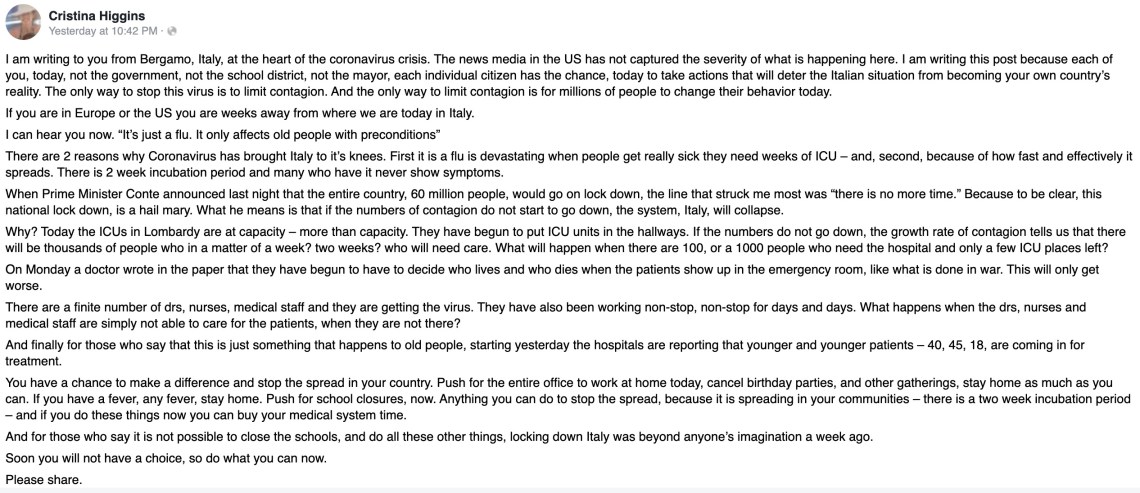
[** Here is more context from NBC about this letter***]
[*] How do I protect myself and society? The official response from the centers for disease control and prevention is available here. The most important step they recommend is washing your hands frequently and avoid touching your face.

[*] The New York State government explains how to protect yourself from infection:
-
- Wash your hands often with soap and water for at least 20 seconds. If soap and water are not available, use an alcohol-based hand sanitizer.
- Avoid touching your eyes, nose, and mouth with unwashed hands.
- Avoid close contact with people who are sick.
- Stay home when you are sick.
- Cover your cough or sneeze with a tissue, then throw the tissue in the trash.
- Clean and disinfect frequently touched objects and surfaces.
[*] U.S. Surgeon General Jerome Adams created a video on the official U.S. Department of Health and Human Services YouTube channel that explains how to properly wash your hands. Watch the video because there’s a good chance you haven’t been washing your hands correctly.
https://www.youtube.com/watch?v=XnJ1wvlIcbs&feature=youtu.be
[*] Here is a Twitter thread of other tips that include: avoiding intense exercise, fasting, and alcohol consumption because they can weaken the immune system.
[*] Social distancing is also probably critical. In fact, Yascha Mounk, an academic and writer specializing international studies notes for The Atlantic: “So far only one measure has been effective against the coronavirus: extreme social distancing. Before China canceled all public gatherings, asked most citizens to self-quarantine, and sealed off the most heavily affected region, the virus was spreading in exponential fashion. Once the government imposed social distancing, the number of new cases leveled off…”
https://twitter.com/scottleibrand/status/1237909696683491328
[*] Should I be freaking out? No, freaking doesn’t solve anything. An informed response can help, though. Keep up to date with reputable sources informed by scientists at cdc.gov and the resource center from Johns Hopkins University. The FDA also has a page.
[*]What should I do if I think I have COVID-19? Here is what the government says to do.
[*] What does Donald Trump think? On Feb 29, 2020 Trump gave his first press conference on it. He shrugged off the danger of the virus particularly as it relates to young/healthy people: “If you’re healthy, you will probably go through a process and you’ll be fine” he said. On March 11th, in an address from the oval office, Trump changed his tune but boasted that his administration responded at “the very start of the outbreak” to “put in place the first federally mandated quarantine in over 50 years,” this time regarding travel restrictions to China. He also announced he’d be suspending all travel from Europe for the next 30 days. He noted that the virus disproportionately affects the elderly and that “older Americans should avoid non-essential travel in crowded areas.” Trump said he’d instruct the Treasury Department to defer tax payments for individuals and businesses that have been negatively affected by the crisis. He also said he’d recommend that progress “provide Americans with immediate payroll tax relief.”
[*] Trump’s Oval Office speech was widely criticized. New York magazine said that he failed to mention “the central problem in the American response to the coronavirus, which is the lack of a functioning testing regime.” CNN lamented that the speech “featured the same sort of scapegoating and barely-veiled xenophobia that Trump has reached for in other moments of crisis during his presidency.” House Speaker Nancy Pelosi says that despite Trump’s speech, he has failed to endorse legislation she proposed that would directly address the outbreak’s economic fallout.
[*] On March 12th, Coronavirus expert Dr. Fauci and CDC head Dr. Redfield testify before House. This is ongoing and live below.
[*] What is coronavirus doing to the economy? The stock market has entered bear territory and a recession could be forthcoming. The economic fallout is complicated. But here are three important points:
[1] Markets are crashing (or more accurately, volatile) because there is confusion about the future. We have no idea what to expect. It could be bad, it could be horrendous, it could be fine, it could be anything! Once there is more certainty about what coronavirus will do, even if it’s bad news, the markets will likely stabilize as they can begin to factor in what the economic future will be.
[2] We don’t really know what is going on in China…. But one thing we do know is that factories aren’t making as much stuff and basically everything we buy is from China…. Axios reports that 75% of companies have been hit by this already. For example, even here at Thought Catalog, we are no longer selling certain cell phone cases because our suppliers can’t meet demand. But it’s also affecting important things like supply chains of making pharmaceuticals.
[3] Local economies are at great risk. This is radically oversimplified, but it’s the basic premise of the threat to small and local businesses. Imagine a restaurant pays $10,000 per month in rent and brings in about $30,000 per month in revenue. Now imagine because people aren’t going out as much, revenue declines to $12,000 per month and they only have a few months of savings and must shut down…. Now imagine the ripple effect across the local area, then state, then region, then country… And this is happening basically everywhere.
[*] Major events that have been canceled or suspended because of coronavirus include the SXSW, Coachella, the NBA season, and even a conference being held about coronavirus conference, etc. Most schools, colleges, and corporate campuses are also shutting down.
[*] What does coronavirus look like? NPR has photos of what it looks like under a microscope. This article shows what it looks like when it gets into your lungs.
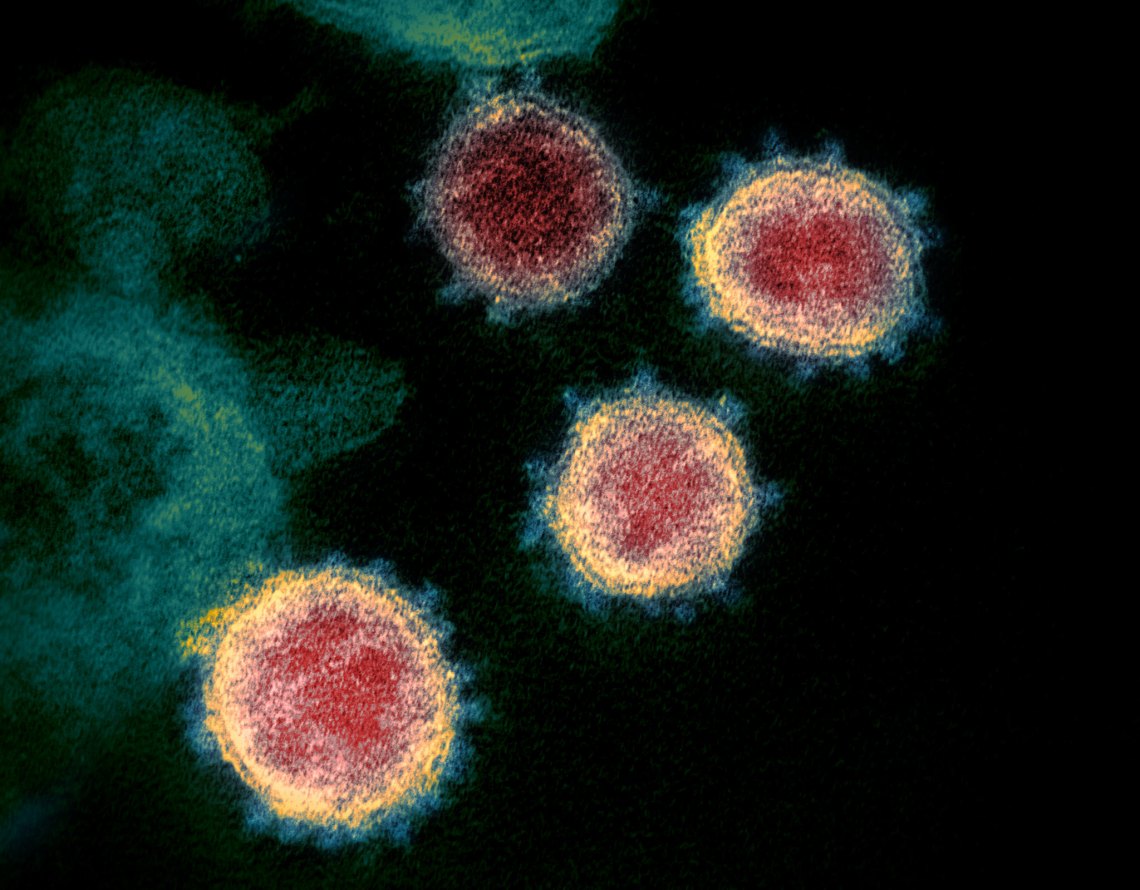
[*] Coronaviruses are called coronaviruses because under the microscope they look like “crowns” that attach to the lungs. Corona is Latin for crown.
[-] Why are we calling this coronaviruses COVID-19? WHO is calling it that simply because it’s a coronavirus that first appeared in 2019 hence COVID-19. The actual official name of the virus itself is The actual virus strain is severe acute respiratory syndrome coronavirus 2 (SARS-CoV-2).
[*] According to Johns Hopkins, coronaviruses normally affect animals. In rare instances, coronaviruses can move from an animal to a human (this is called a zoonotic disease). The current strain of the coronaviruses — COVID-19 — is currently what we are worried about.
[*] Previous coronaviruses that scared us were SARS and Middle East respiratory syndrome (MERS). It seems that the COVID-19 strain is more contagious than previous coronaviruses.
[*] Where did this coronavirus, COVID-19, come from? The early hypothesis is it came from a market in Wuhan, China where the first reported outbreak was. In the words of Gao Fu, director of China Center for Disease Control and Prevention: “The origin of the new coronavirus is the wildlife sold illegally in a Wuhan seafood market.”
[*] Here is Dr. Christian Walzer, executive director of the WCS Wildlife Health Program, explaining these markets in greater depth.
[*] The New York Times has a cultural analysis of why a demand exists in China for live animals and illegal wildlife.
[*] The Chinese government has vowed to crack down even more intensely on these markets. Xi Jinping, the general secretary of the Communist Party of China, said:
We have long recognized that the consumption of wild animals is very risky, but the “game industry” is still huge and poses a major hidden danger to public health and safety. Never be indifferent again! I have given instructions on this issue. Relevant departments should strengthen the implementation of laws, strengthen market supervision, resolutely ban and severely crack down on illegal wildlife markets and trade, resolutely eliminate the bad habits of overeating wildlife, and control major public health risks from the source.
[*] So is COVID-19 brand-new? Yes, it would seem it is, at least in terms of it infecting humans. That said, coronaviruses like SARS-CoV are not new. We also can’t reach a definitive conclusion if scientists knew about COVID-19 in animals before the human outbreak; if you know or have links please email us at hello@thoughtcatalog.com.
[*] We do know other forms of human coronaviruses were first identified in the 1960s but have not led to epidemics or pandemics. Human coronaviruses 229E and OC43 are two of the viruses responsible for the common cold.
[*] According to Wuhan-based virologist Shi Zhengli, “the SARS outbreak was a game changer” because it was the first time scientists observed a lethal coronavirus that could trigger a pandemic move from animals to humans. So while COVID-19 is new in humans, you could say SARS is like a sister virus or something like that.
[**] Shi Zhengli is briefly nodded to in the movie Contagion directed by Steven Soderbergh, and that movie about a pandemic was inspired by the 2003 SARS epidemic and the 2009 Swine Flu pandemic.
[*] What is up with coronavirus and bats? According to the The World Health Organization, our best guess of where the SARS coronavirus came from is viruses in bats. So there is a concern bats are also where COVID-19 came from, at least that’s a leading hypothesis.
[*] Bats? Really? According to a study from University of California, Berkley: it seems the “worst viral disease outbreaks in recent years — SARS, MERS, Ebola, Marburg and [COVID-19] originated in bats.” Why? It appears bats have strong immune systems, so viruses can live in them and then transfer to animals with weaker systems; though if you look deeper into all the scientific observations a much more complicated picture emerges. Go down the k-hole in this paper or this one, which dives scientifically and with great complexity into the subject.
[*] What countries have been most impacted? As of this writing, China, Italy, Iran, South Korea, France, Spain, Germany, the United States, Switzerland, and Japan are the most affected.
[*] China was initially criticized for either a slow response to the outbreak or a deliberate coverup, but many mainstream news organizations report that the country has taken aggressive measures that have slowed down its spread considerably. Other sources say China is lying about the success of its containment efforts. Again, as of this writing, we just don’t know.
[*] Is containment working anywhere? In Singapore containment is working, which is wild because initially Singapore was the worst-hit nation outside of China. However, according to the World Economic Forum, containment is so effective in Singapore because the country has a “unique combination of factors… a top-notch health system, draconian tracing and containment measures, and a small population that’s largely accepting of government’s expansive orders. Few other countries battling an outbreak that’s now infected more than 83,000 globally and killed over 2,800, can replicate these circumstances.”
[*] Italy, which currently has more cases and deaths than any country outside of China, may have botched the crisis in mid-February when it forced a 38-year-old man infected with coronavirus to wait 36 hours before treatment, spreading the virus to untold numbers of patients and hospital staff. Italy’s prime minister tried to blame regional presidents for the initial slow response; in turn, regional presidents blamed the central government for not properly anticipating the scope of the outbreak.
[*] The Italian College of Anesthesia, Analgesia, Resuscitation and Intensive Care released a document claiming that the country’s medical resources have been so rapidly overloaded by the outbreak that in the course of a mere week, they’ve switched from high-quality care for individual patients to wartime triage to what they are now calling “catastrophe medicine.” The document urges that patients with the highest hope of survival be given priority in treatment. It says that “It may become necessary to establish an age limit for access to intensive care,” ostensibly because older people have a lower survival rate.
[*] Tom Hanks and Rita Wilson have coronavirus. Their description of the virus reads: “We felt a bit tired, like we had colds, and some body aches. Rita had some chills that came and went. Slight fevers too. To play things right, as is needed in the world right now, we were tested for the Coronavirus, and were found to be positive.”
[*] What is the incubation period for COVID-19? In other words, if I have it how long does it take for me to show symptoms? According to the journal Annals of Internal Medicine, “this work provides additional evidence for a median incubation period for COVID-19 of approximately 5 days, similar to SARS.” So it seems about five days.
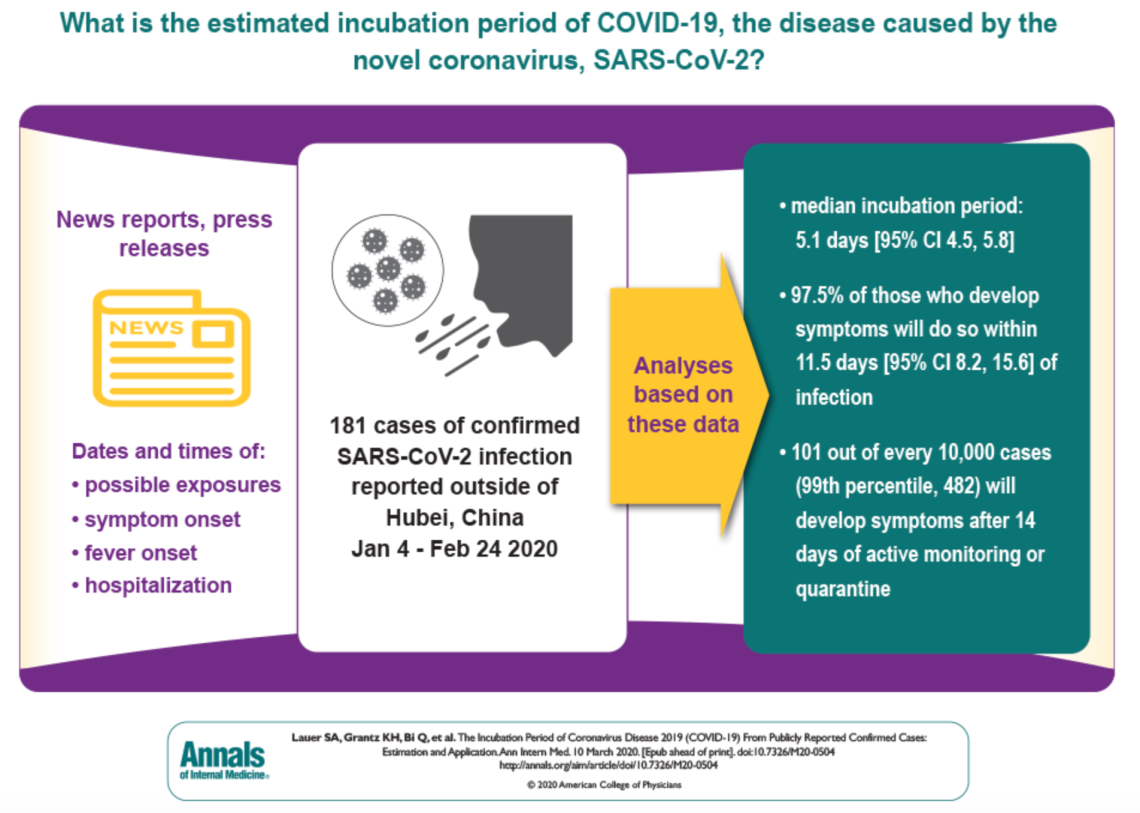
[*] When will coronavirus go away? Will warm weather get rid of it? Again, we don’t really know. However, consider these two observations. 1 — Warmer countries next to China don’t seem to be having massive spread of the disease and 2 — repository diseases like coronaviruses seem to peak in winter during cold months. You can read analysis of this here or the source material on the matter here for the nitty gritty details of the seasonality of COVID-19.











